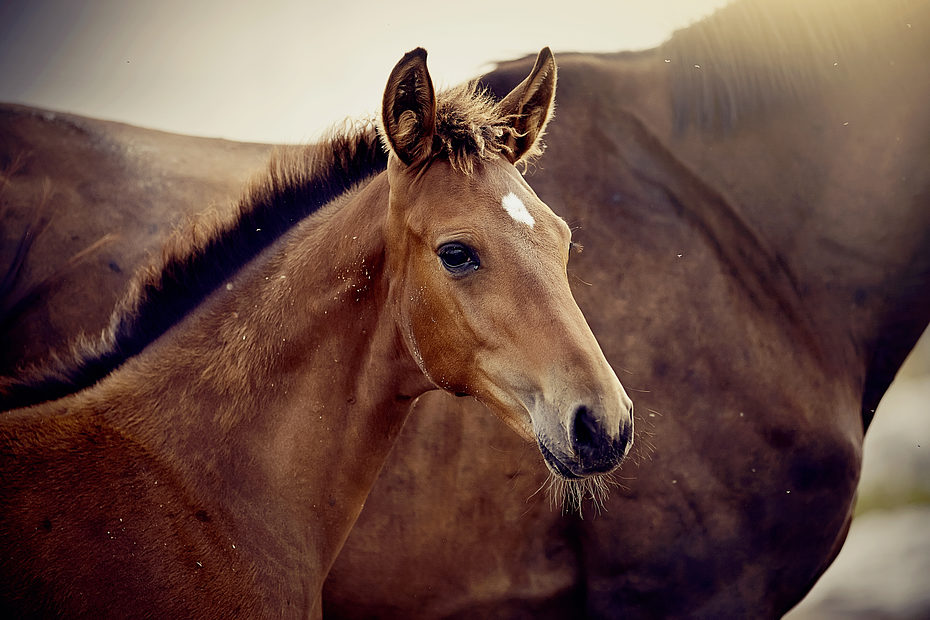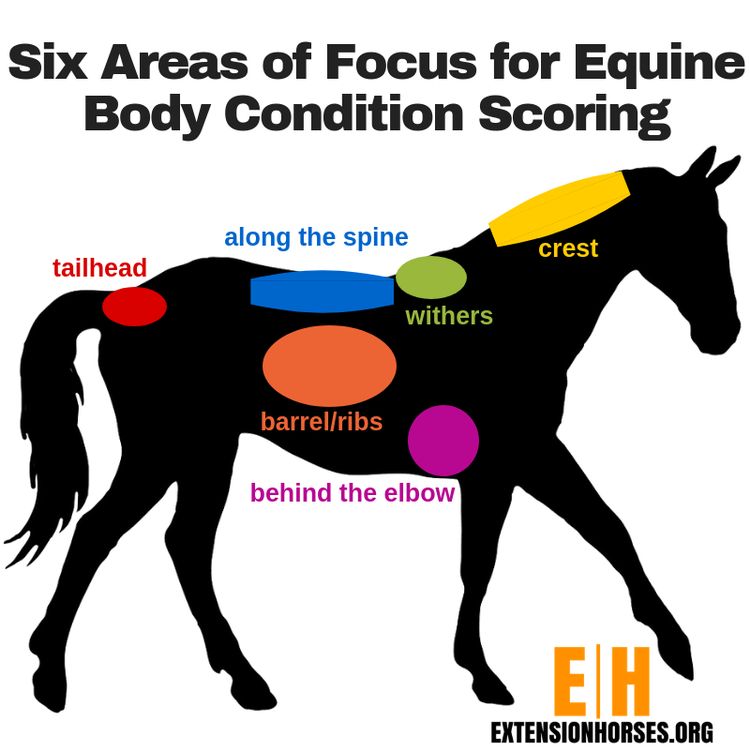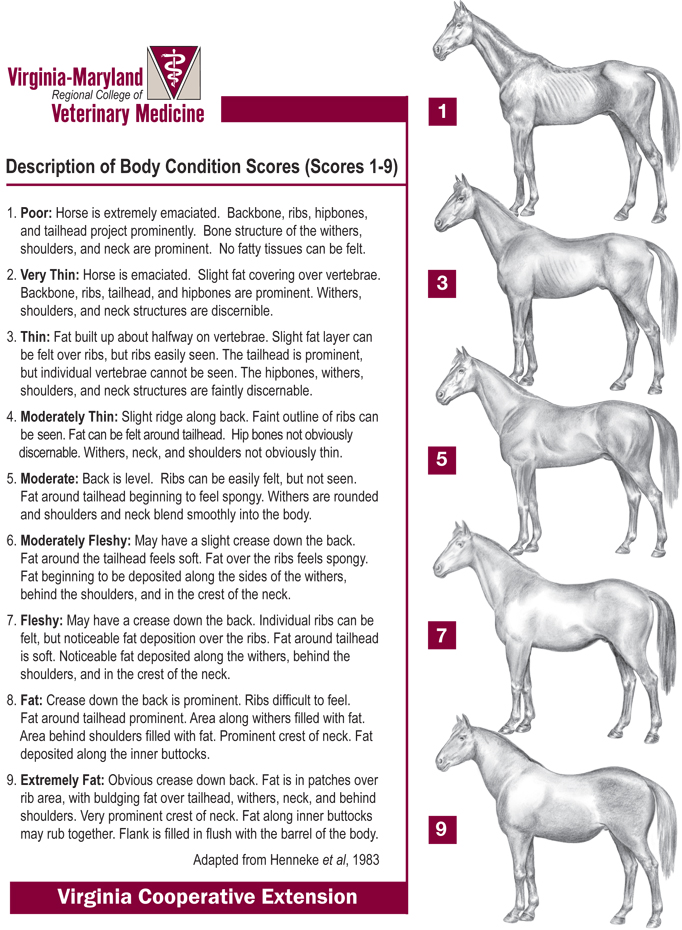Posted July 26, 2021
Foaling season can be exciting and stressful for many horse owners.
Optimal nutritional management of broodmares, during gestation and early lactation, can ensure the best outcome for both the mare and foal.
The main goals of mare nutrition, during gestation and at foaling, are to ensure she has adequate body condition to maintain growth of her foetus, that she can produce adequate milk for her foal post parturition, and she is prepared and reproductively sound to go back into foal, if required.
The key areas of focus during this time include the mare's body condition, protein intake, energy, vitamins and minerals, alongside adequate fibre and water intake.
Body Condition Scoring
Throughout the mare’s lifetime, her body condition score should be closely monitored. The Henneke Body Condition Scoring system is a helpful tool used to determine your horse’s body condition (Baker et al, 2020) (see Figure 1 on the left). During the last trimester of pregnancy, mares should be maintained as closely as possible to a body condition score of 6 on the Henneke scale (see Figure 2 on the left).
A visual assessment, alongside a physical examination by touching along the horses ribs for example, are helpful ways to determine relative body fat.
As shown in Figure 1, there are 6 main areas of focus when condition scoring your horse. While assessing these areas, an estimate of the horse’s body condition score can be determined by referencing the table shown in Figure 2.
Nutritional Requirements & Body Condition
The protein and energy requirements of mares averaging 500kg increases by 35% and 29% respectively from early to late pregnancy.
This is especially prevalent in the third trimester during which 75% of foetal growth occurs. Nutritional requirements for vitamins and minerals must also be increased during this time (Huntington et al, 2005).
It is important that mares do not become overweight (Henneke condition score 7 and over). Overweight mares may be susceptible to milk production issues after foaling, discomfort from added strain on joints and hooves, and impaired ability to become pregnant again (Richards, 2019).
It is also important that mares maintain a positive energy balance and do not become underweight (score 5 or less), otherwise they may lose weight after foaling when protein and energy requirements increase by 33% and 52% respectively for a 500kg mare (Huntington et al, 2005). This means that the mare will have less body reserves of protein and energy needed for milk production. Underweight mares may also be more susceptible to disease and reproductive issues (Richards, 2019).
Designing Your Feeding Program
It is important to develop a feeding program as early as possible and assess your mares’ nutritional requirements using a reputable information resource. There are many factors that need to be considered, some of which include:
Fibre Sources
What pasture, hay or other fibre sources are available now and what will be available through the entire gestation?
Is the quality and quantity adequate to meet the mare’s requirements?
Keep in mind that pasture and/or hay should make up the greatest proportion of your horse’s diet.Body Condition
Is the mare in adequate condition?
Does she need to gain or lose weight?
Is it typically difficult or easy for her to maintain her condition?
This may prompt you to decide on what type of supplement needs to be provided.Supplementation
Does the mare require more protein, energy, vitamins and minerals, or only some additional nutrients?
Mare Supplement Considerations
If your mare requires supplementation, it is important that she is provided with good quality protein sources, which provide essential amino acids, such as soybean meal and canola meal, alongside lucerne hay.
Energy intake from pastures and/or hay should fulfil most of the mares’ requirements, but during times of increased energy demand, such as during pregnancy and lactation, cereal grains in cooked feeds can be provided to balance their requirements.
If providing any supplementary feeds, vitamins, minerals etc. it is important to feed to the rate recommended by the manufacturer. Also, if you are planning on adding extra minerals, vitamins and other supplements to your horses’ diet, it is recommended that the entire diet of the mare is assessed first to determine whether they are needed.
These steps should be taken to avoid oversupply and/or excretion of nutrients, and also to make sure you are not spending money on additional supplements that are not required.
If you require a supplementary feed, Riverina Feed and Breed Pellets are formulated to help provide breeding mares and growing horses with a full range of essential nutrients to meet their daily nutrient requirements when fed in conjunction with roughage.
Benefits of Riverina Feed and Breed Pellets:
Good quality protein from soybean and canola meals.
Yea-Sacc® improves fibre digestion and gross energy and amino acid absorption.
Chromium from yeast added to assist glucose metabolism.
Added Vitamin E is an antioxidant that is involved in muscular, circulatory, nervous, immune and reproductive systems.
Extra copper is added and has a role in bone and joint cartilage development.
Key Messages
Keep your mare in an ideal body condition throughout pregnancy and lactation – not over or underweight.
Meet nutritional requirements for energy, protein, vitamins and minerals throughout pregnancy and lactation.
Fibre is king – remember that horses are designed to graze forages and we need to be mindful when incorporating cereal grains into their diet.
Clean, fresh water must be available at all times – if mares do not consume enough water, milk production can be reduced.
Ensure that your mares’ health treatments and vaccinations are up-to-date as recommended by your Veterinarian, and if you are concerned about the health of your mare during gestation and lactation, contact them immediately.
Emma is a certified nutritionist for Riverina Stockfeeds. She is completing her Bachelor’s degree in Agriculture (Animal Production) and has worked for Riverina for 11 years.
References
Huntington, Peter & Owens, Elizabeth & Crandell, Kathleen & Pagan, Joe. (2005). Nutritional management of mares-the foundation of a strong skeleton. Advances in equine nutrition III.
Image of horse body condition scoring. (2019). Retrieved from ttps://www.canr.msu.edu/news/body_condition_scoring_in_horses.
Image of Henneke system. Virginia-Maryland Regional College of Veterinary Medicine and Virginia Cooperative Extension, Blacksburg, Virginia, USA (2012).
Lance A Baker, Amanda M Burrows, Kelsey J Nonella, John L Pipkin, Logan D Holmes, Trent J McEvers, Travis C Tennant, Zane M Tisdale, Austin H Voyles, Ty E Lawrence, Relationship between live body condition score and carcass fat measures in equine, Translational Animal Science, Volume 4, Issue 4, October 2020, txaa179, doi.org/10.1093/tas/txaa179
Richards, N. Feeding pregnant mares. Feed XL, Equilize Horse Nutrition. feedxl.com/19-feeding-pregnant-mares/ accessed 1/7/2021
Richards, N. Feeding the lactating mare. Feed XL, Equilize Horse Nutrition. feedxl.com/46-feeding-the-lactating-mare/ accessed 1/7/2021







 Beef
Beef
 Dairy
Dairy
 Sheep
Sheep
 Horse
Horse
 Pig
Pig
 Goat
Goat
 Poultry
Poultry
 Bird
Bird
 Dog
Dog
 Special
Special
 Feed Materials
Feed Materials